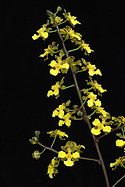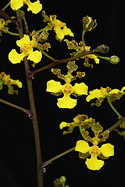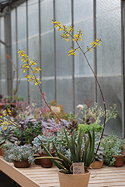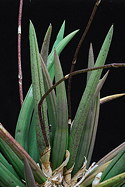A number of xeric orchids have stood the test of time in the Huntington’s Desert Conservatory, none more so than Oncidium longifolium. This widespread Tropical American species has stout, cylindrical leaves resembling those of Sansevieria erythraeae. Yet its true affinities are revealed after the lengthy gestation (3 months) of the slender arching inflorescences to a meter or more in length. The globular buds finally burst forth in March to reveal typical Oncidium flowers of bright yellow speckled with red. The species is variously said to be a synonym of O. cebolleta (Jacq.) Sw. or Trichocentrum cebolleta (Jacq.) M. W. Chase & N. H. Williams, and has recently been recombined in 2010 as Cohniella longifolia (Lindl.) Catzal & Carnevali. We offer HBG 108062, plants grown in vitro from seed, set on HBG 58229, pollinated by a plant from northwest of Ciudad Valles, San Luís Potosí, Mexico. The female parent has historical significance for the Huntington and succulent collectors as it was collected by Myron Kimnach on his first expedition to Mexico: Kimnach & Moran # 89, collected Nov 1, 1959, in Sinaloa, 58.2 mi N of Mazatlán, along the highway, at 300' elevation. $12.
According to Germán Carnevali who recently revised this group of orchids, they are more appropriately recognized in the genus Cohniella. Furthermore, O. longifolium has been a bit of a catch-all for several related but distinct taxa in Carnevali’s scheme. Therefore, it turns out that our offering was a cross of two species: C. leptotifolia (Lindl.) Catzal & Carnevali, the one used to illustrate our offering, from Sinaloa with C. biorbicularis Balam & Cetzal from San Luís Potosí, a species with longer, more slender leaves and with the lateral lobes of the labellum larger, rounder and showier.

Published in the Cactus and Succulent Journal, Vol. 84 (2), March - April, 2012





